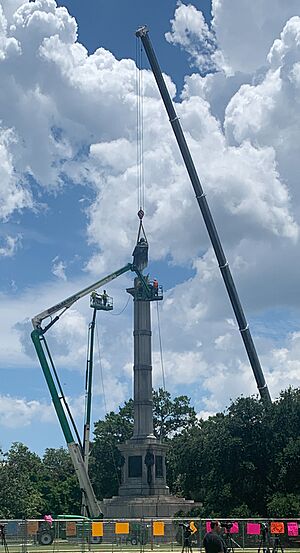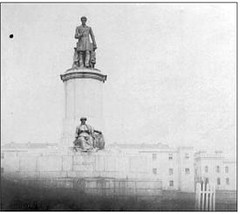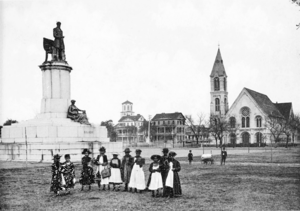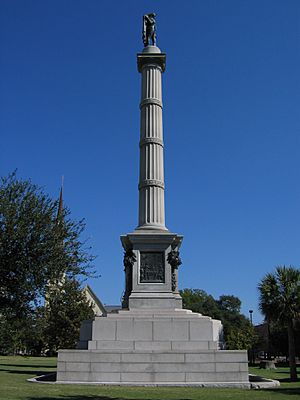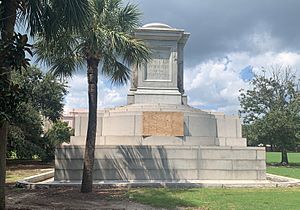John C. Calhoun Monument facts for kids
John Caldwell Calhoun (born March 18, 1782, died March 31, 1850) was an important politician from South Carolina. He held many roles in government, but he is best known for being the Vice President of the United States from 1825 to 1832. Calhoun strongly supported slavery in the United States. He led a group in the Senate that wanted to keep slavery and even expand it to new parts of the country. Calhoun famously said that slavery was a "positive good," not just a "necessary evil." He died in Washington D.C. in 1850.
After Calhoun's death, people in Charleston, South Carolina, wanted to build a monument to honor him. This monument stood for over 120 years, but it was taken down in June 2020. The monument had a long history of debate and disagreement, from when it was first planned to when it was finally removed.
Contents
Building the Calhoun Monument
Soon after John C. Calhoun died in 1850, a group called the "Ladies' Calhoun Monument Association" (LCMA) started working to build a monument for him. Their goal was to create a monument in Charleston to remember Calhoun.
The group faced some challenges in raising money for the statue. They held meetings and relied on donations from wealthy people in Charleston to collect enough funds.
The First Calhoun Statue (1887)
After 27 years, in April 1887, the Ladies' Calhoun Monument Association celebrated the first monument being put up. There were parades and celebrations across the city. The LCMA helped show the statue to everyone who came to the event. They said that Marion Square was "crowded" with people for the unveiling.
However, this first statue did not last long. People who had been enslaved, known as Freedmen and women in Charleston, began to damage the statue as a way to protest. Soon, the statue hardly looked like John C. Calhoun anymore. This meant the LCMA had to start over and make new plans to keep the monument safe from public damage.
Even though it wasn't written on the monument, many people felt its purpose was to send a message to Black Charlestonians. Mamie Garvin Fields, who was born in 1888, later said that she believed "white people were talking to us about Jim Crow through that statue." Many other Black Charlestonians felt the statue was a threatening reminder of Calhoun's ideas, even after he was gone.
The Long-Standing Calhoun Statue (1896)
The version of the statue that stood the longest was put up by the LCMA on June 27, 1896. This time, there wasn't much celebration. The local newspaper, The Post and Courier, didn't even mention the new monument that day. The Ladies' Calhoun Monument Association said the statue cost about $20,000 in 1896. This would be like paying over $500,000 today.
An Irish builder named Daniel A.J. Sullivan completed the 1896 monument. He was a skilled carpenter who became a well-known builder in Charleston after the American Civil War. It is believed that African American workers likely helped build the monument in 1896. At that time, many carpenters, stonemasons, and laborers in Charleston were African American.
For the next 120 years, the John C. Calhoun monument stood in Marion Square as Charleston changed around it. Over time, some groups tried to bring attention to the monument and how it was seen by different people. Some believed removing the statue would be "erasing history." Others felt it would be "reshaping a false notion of history." After a tragic event in Charleston in 2015, the debate over the John C. Calhoun Monument became a national topic.
The Monument's Final Years
In the summer of 2020, many monuments and statues across the United States were taken down during protests. These statues often honored people who supported slavery or represented ideas from the "Lost Cause" movement. The John C. Calhoun monument had been a difficult issue for Charleston for many years. After the 2015 event, people in Charleston questioned the monument's purpose, but no agreement was reached on what to do with it. Ideas to change the statue were often ignored or dismissed.
In 2017, a group was formed to think about how people could understand the statue better. This group was supposed to create a plaque to give more historical information about the statue. However, they could not agree on the words for the plaque, and the group was eventually stopped.
In 2020, local activists and the city council took action. On June 23, 2020, after a long process, the John C. Calhoun statue was taken down from its tall base. The statue's current location is not known to the public. Some groups have suggested putting the statue in a museum. However, the Charleston Museum said they did not want it. As of October 2020, no museum or historical society had claimed the statue.
|


